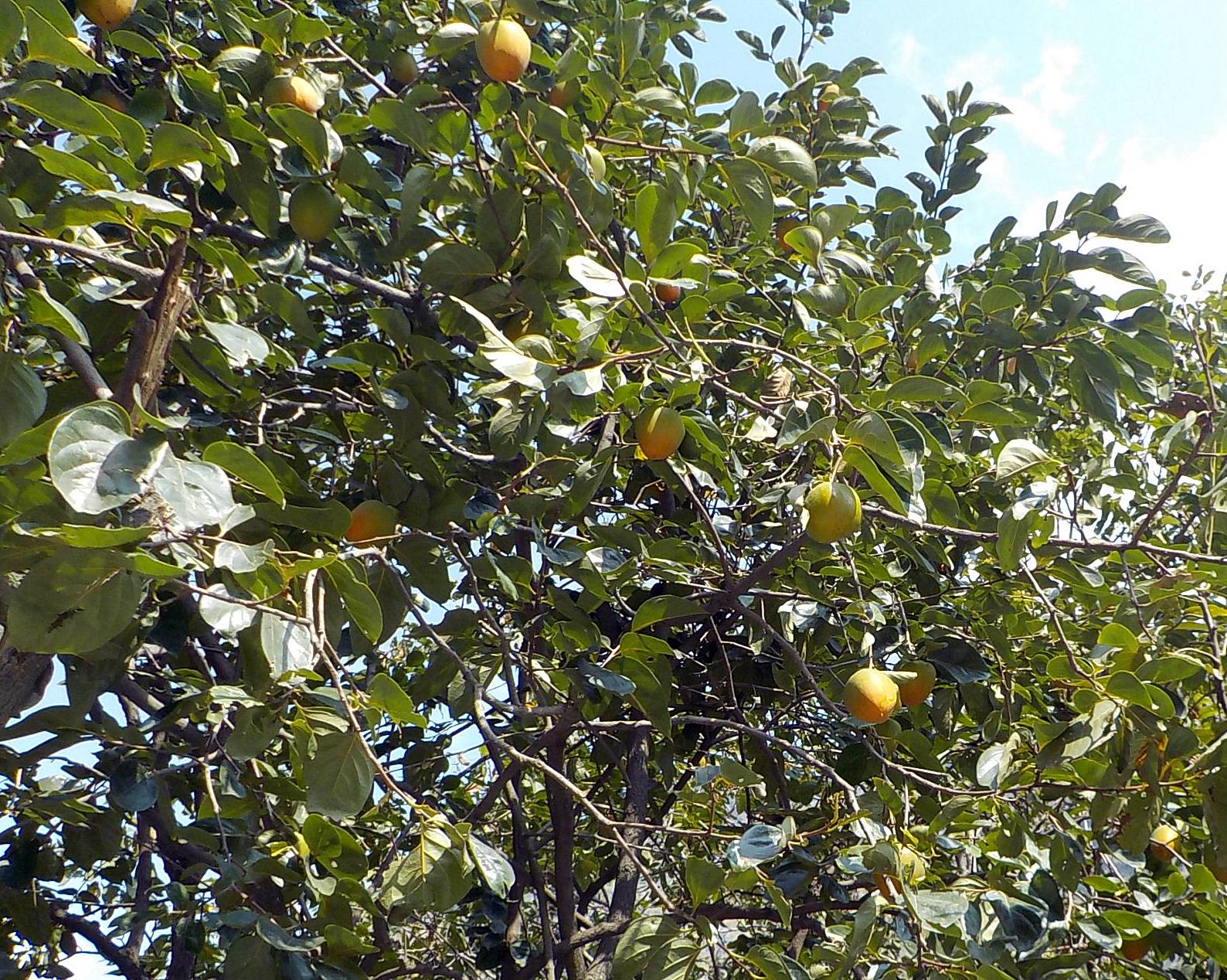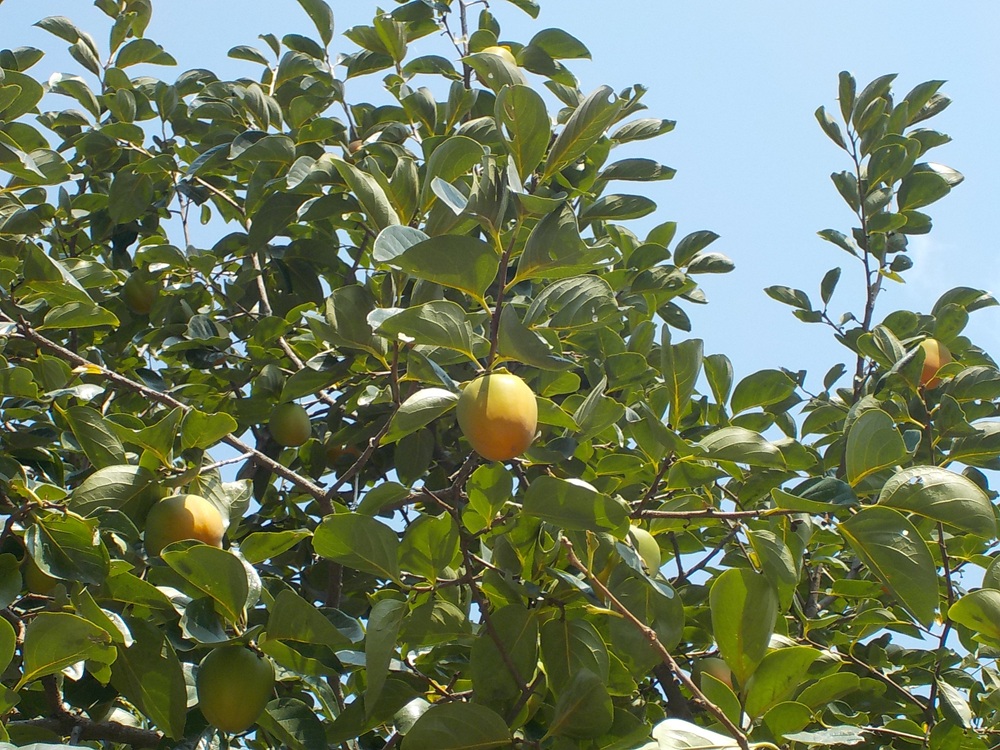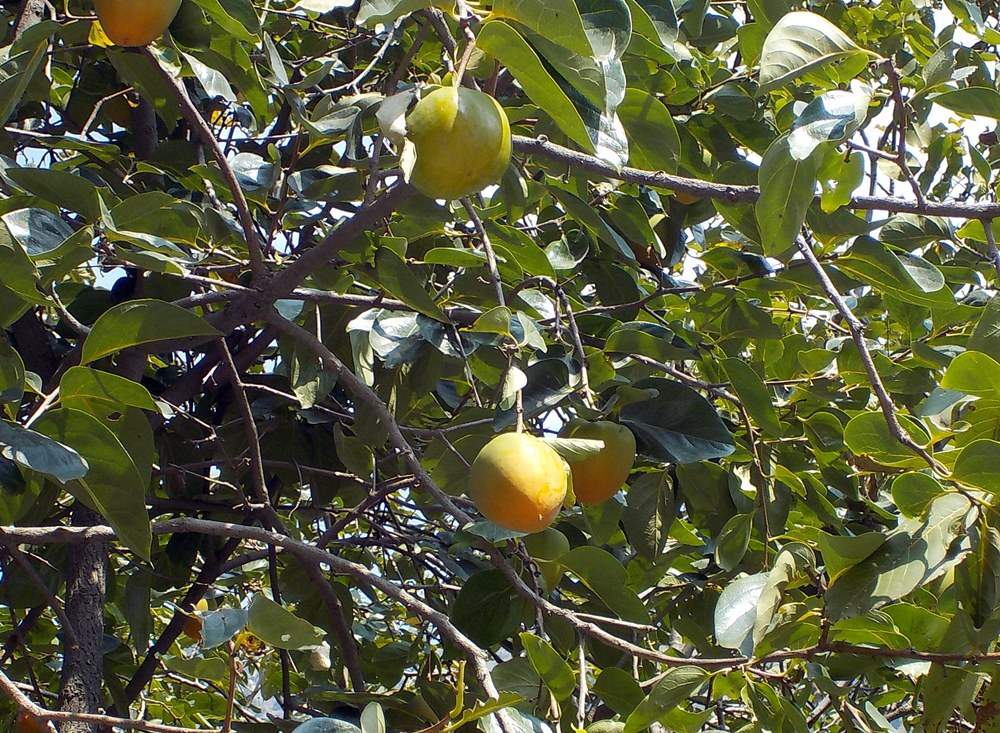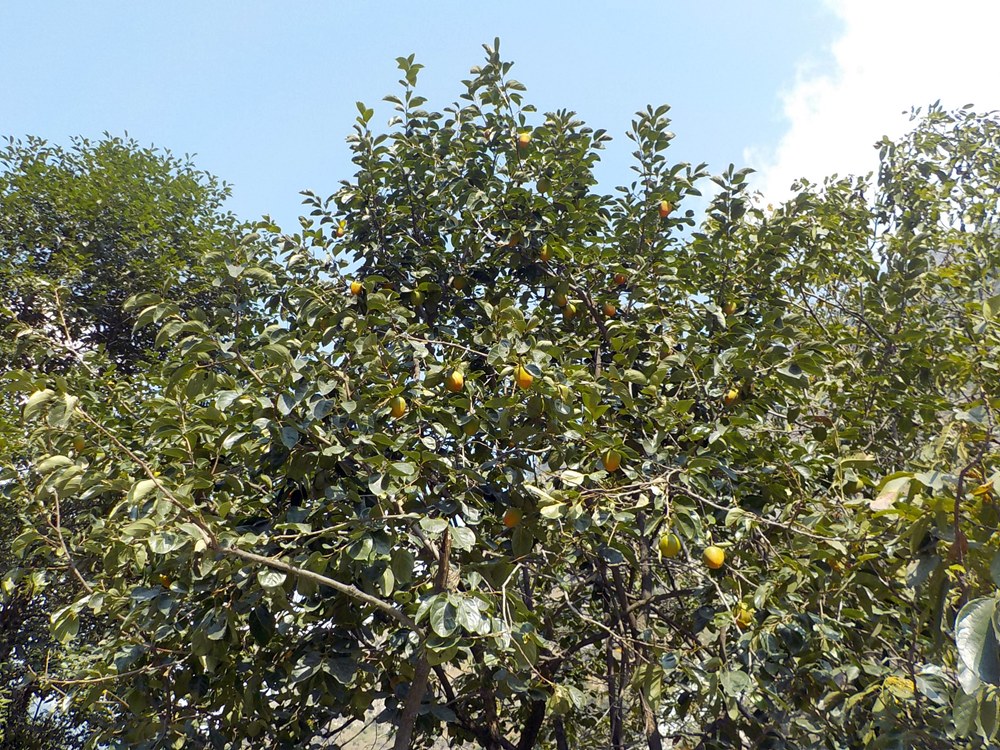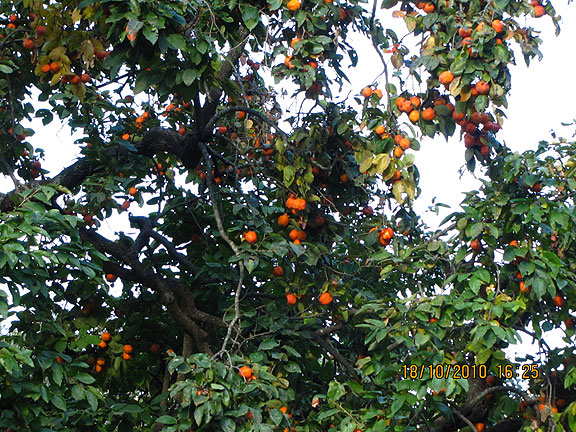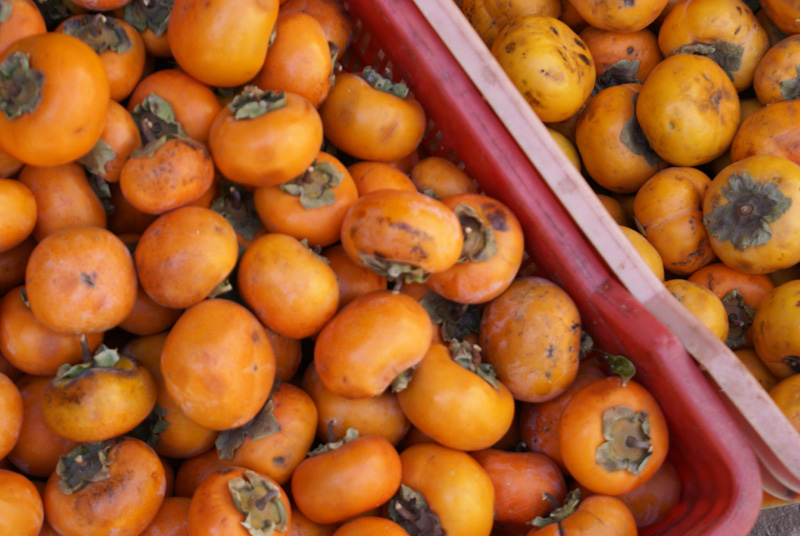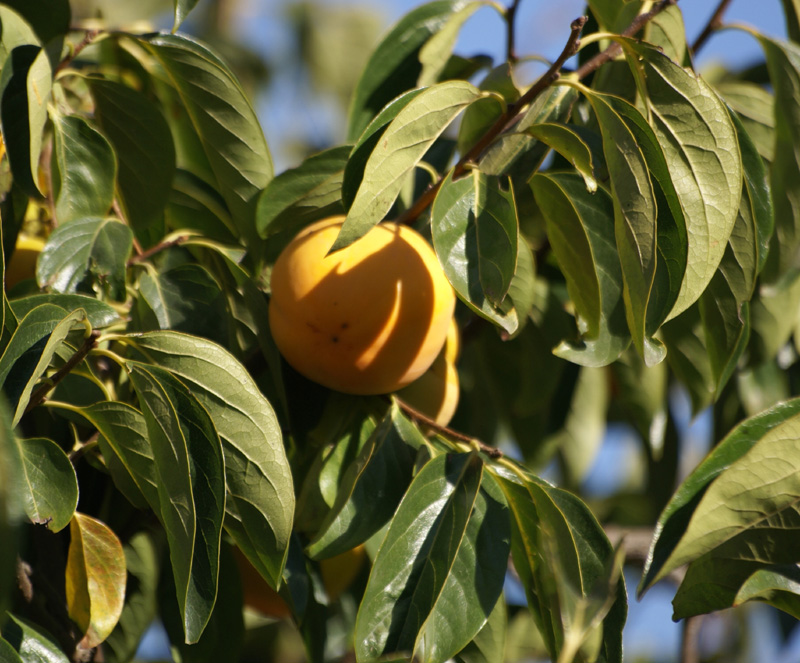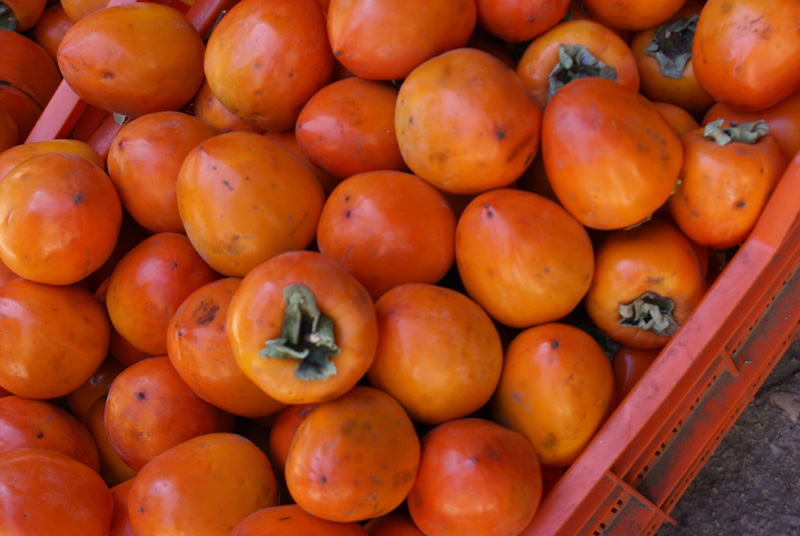|
Diospyros kaki Thunb., Syst. Veg. ed. 14 918 1784. (syn. Diospyros amara Perrier; Diospyros argyi H.Lév.; Diospyros bertii André; Diospyros chinensis Blume [Invalid]; Diospyros costata Carrière; Diospyros kaempferi Naudin; Diospyros kaki var. aurantium André …….; Diospyros lycopersicon Carrière; Diospyros mazelii E.Morren; Diospyros roxburghii Carrière; Diospyros schi-tse Bunge; Diospyros sinensis Naudin; Diospyros sphenophylla Hiern; Diospyros trichocarpa R.H.Miao; Diospyros wieseneri Carrière; Embryopteris kaki (Thunb.) G.Don; Diospyros schitze Bunge);
.
Japanese Persimmon, Oriental Persimmon, Kaki, Asian Persimmon, Sharon Fruit, Korean mango; Hindi: halwa tendu;
.
Small tree for identification from Pelling:: NS April 2018-02 : 3 posts by 2 authors. Attachments (7) Yes, … It is D kaki no doubt but hope you saw in cultivation.
Diospyros kaki L.f. : 3 posts by 2 authors. Attachments (4) Location: Kathmandu, Nepal
Altitude: 4400 ft.
Date: 9 December 2017
Japanese variety.
Flower: 16 April 2015
Raw Fruits : 8 August 2015
Ripe Fruits : 2 October 2014 Is ID ok ? Appears so as per images at And I tasted, what I thought was TOMATO: I went to city to buy some stuff with one of our staff members, … While we were returning, I bought some guava and she bought some, what I thought was tomato. Then she came to me and gifted me one of those tomato and asked me to try it.
I smiled, “I know how tomato tastes”. She said, “no this is not a tomato”. Hesitantly, I took it and came home. In the evening she called me to say, “wise man, you are too bad”. I said,” why?”. She replied, ” when a girl gifts you something you should have gifted her the guavas”. I couldnt stop laughing. She asked, “did you taste the fruit, do it now if you haven’t and you will know its not a tomato”. And finally I tasted what I thought to be tomato. And I am glad that I was wrong. Its one of the best fruits I have ever tasted. Very peculiar color and very peculiar taste. Its commonly called the Persimmon.
Diospyros kaki Thunb. Family: Ebenaceae This is a very high value medicinal plant. Wow very interesting. They even sell the inflated dry fruits. Never tasted them yet. Willtry soon :)Its good for health 😛 I am surprised you could not identify persimon, although this one is more reddish than usual one. I had uploaded both astringent (when not fully ripe) and non-astringent types. But don’t worry I feared worst when I came to Delhi. I had seen a girl for match (she is now my wife) in 1976. Next day her brother and sister came to my place. I asked them to wait in my room, and rushed to the next fruit shop, bought what I thought strawberry, only realizing after the shopkeeper handed it over to me, that was not strawberry. I rushed home, gave them the fruit and told them to eat it the way you like. Later I came to know that it was litchi. Hahahaha, thats funny sir…. good good your litchi worked :)) Is this fruit available in India? In plenty in temperate areas, especially Kashmir, Manali, Nainital, etc. I had uploaded two Manali, thinking one to be American D. virginiana, but as it turned both were D. kaki, one astringent form and one non-astringent form. Here is the link.
Oh I thought these grow in tropical areas. Yesterday someone on my facebook was saying she found it in Kullu!! Definitely this fruit can be purchased from Manali, I had got an opportunity to taste this (and I thought this to be any member of Solanaceae, more inclination being towards Tomato). They sell it and tell the name as Persimon, thus no doubts remain pending if you buy it from there. …, Is this fruit same as Tree tomatoe? If you have not given guava, please give it now only to her. Better late than never. and also please see that it is guava only not any other fruit !! Yes Kullu also. Now …, you have to give guava to her. So many well wishers want you to do that. No …, tree tomato is different. According to Wikipedia, tree tomato is Solanum betaceum. diwali is the season for persimmons There was a tree in our neighbourhood in Kashmir when we were little children, but unfortunately the astringent variety. We would be tempted to pluck the fruit but if it was slightly unripe it would leaves a very burning sensation in the mouth, so we would wait for fruits to ripen before plucking. Only after nearly 55 years I came to know, when we visited Kullu Manali in 2009 that there are two varieties of Diospyros kaki, and that also only after …, our member from California informed me. Earlier I thought one was D. virginiana and another D. kaki. Now I have seen lot of D. virginiana in California and would upload some day. This persimmon is currently being sold in Mumbai as ‘Amarphal’. The fruit vendor said that they are sourced from Kashmir. Have attached some cell-phone shots of the fruit; diameter : 7 cm. Seed size : 2.5 cm long x 0.8 cm wide. This is the astringent one. Eat only if fully ripe, when it is really sweet. Two years back one of my friend brother brought from Saudi area as a Kashmir Sapota. It may be a Diospyros virginiana. Please visit site Wow today is Diospyros day!!! 🙂 Initially I also thought one growing in Kashmir as D. virginiana, but only after Kenneth told me and saw D. virginiana in California that I came to know than both elongated orange red fruits (astringent one) and depressed yellow ones belong to D. kaki only. D. virginiana has larger, distinctly glaucous and thicker leaves. We get these fruits in germany, they come from Israel. When they are ripe they taste really juicy and sweet. I like them. if you are blood group B… dont overindulge in Persimmons… like eat it everyday of the season… if you are in Kolkata… I think your fruit is different, its Diospyros virginiana. Diospyros kaki?? at Sainj – GHNP- PKA97 : 3 posts by 2 authors. Attachments (4). yes
we know it as Japanese persimmon makes nice jelly Fruits For ID : Diospyros Species : California : 11JAN15 : AK-17 : 4 posts by 2 authors. Attachments (2) Diospyros kaki ‘Fuyu’ Diospyros kaki Thunb. ?? : 4 posts by 2 authors. Attachments (1)
Location: Chautara, Nepal
Date: 16 December 2017
Altitude: 5600 ft.
Cultivated !
I think difficult to confirm with this image. You are the best judge.
Pl see Diospyros kaki
It is commonly available Persimmon allover Nepal.
As such I think it is D. kaki.
OK This shot was taken in Mayabti, Uttaranchal. Local people told me that it is a peach tree.
I request for the exact id of this tree.
Unfortunatlely, I do not have other pics.
This is a long shot hence very hard to say. but keep one thing for sure if the fruits have a glossy skin it can never be peach, peach always From such a distance, it looks like Diospyros kaki. just a funny and yummy thought. Can this be Artocarpus lakoocha :P!! when was the photo taken? It is definitely not peach but if taken in september it could be persimmon . FA I think it is Diospyros kaki Thunb. (Ebenaceae), we call it kesemek, or Japanese persimmon. Yes, looks like Diospyros kaki to me also. Nowadays, Korean market is full of this fruit. People call it ‘Gam’ here. We had few trees in Kashmir, known locally as Amlok Correct ID I guess! .
Request for identification : 6 posts by 2 authors. Attachments (2)- 1 & 2 mb.
I would be grateful if you could identify the tree which I found growing in my garden. The tree is about 12 feet tall and flowers are tiny about 5 mm in dia. Ericaceae sp. ??
It is Diospyros sp, please check the regional Diospyros or possibility for male Persimmon. yes it looks like Diospyros kaki, fruits edible Yes Diospyros kaki, commonly cultivated in Kashmir Thanks for big lead … for nailing it. . Diospyros kaki: 2 high res. images. Yes Diospyros kaki Once I ate this fruit ..that time it was unripe.. it produce lather and even my tongue could not move properly…. Yes, it should not be eaten unripe. .
.
We have hachiya here in Kashmir . Diospyros virginiana & D. kaki – indiantreepix | Google Groups : 4 posts by 2 authors. Attachments (3)
In our childhood we used to pluck fruits (locally called Amlok in Kashmir; although Amlok is more correctly applied to D. lotus, Dateplum persimon with fruits smaller than 2 cm) which would be palatable and sweet only if ripe orange fruits were eaten. If you do the mistake of eating slightly unripe greenish-yellow fruits it would leave you a very bad taste and irritation for many hours. I knew this plant as persimon, a species of Diospyros. When I mentioned about this to my colleague, who had visited Manali earlier, he mentioned that he had eaten unripe fruits without any problem. Fortunately we found two types of fruits in a fruit shop. The first I identified as D. virginiana (unripe fruits are unpalatable, and not sold) and another D. kaki (even unripe fruits are palatable). Former is Common persimon and latter (Japanese persimon, Kaki persimon; HindI; halwa tendu). Local Manali people call both types of fruits as Japanese fruit.
I am uploading both. Comments are solicited. I could be wrong, but I think that these are both D. kaki. There are cultivars that ripen sweet on the tree and others that are astringent until fully ripe, usually off-tree. You may be right, knowing your expertise with US plants. Kindly upload a good photograph of D. virginiana to compare. My identification was based on description in Bailey’s Manual of cultivated plants. May be I will next time catch hold of both types of trees to compare. Sorry, I don’t have good personal pictures of D. virginiana, but I was able to get a few mediocre shots (links below) off the internet. Hopefully they will help.
Both are D.kaki as per Yes …, subsequently I had clicked both (Hachiya and Fuyu) and shared on the post by …
. References:
|
Diospyros kaki
Updated on December 24, 2024

